Watch Dogs 2 Review
This hacking sequel takes the franchise in a new direction with mixed results
As a new IP, and following a long time in development, the original Watch Dogs did well for Ubisoft, selling over 4 million units during the launch week alone. The game successfully combined stealth, action, and the unique aspect of manipulating the world around you via hacking. Not everyone enjoyed the somewhat dark tone of the story and its protagonist. Still, it was a rather solid success and a great game. So perhaps it's no surprise that a sequel would follow, but with Watch Dogs 2, the developers at Ubisoft Montreal have clearly taken many of the fan criticisms of the first game to heart. This follow up, for better or worse, is a very different experience to that of the original. Some fans will love the new tone and feel of this sequel, but others will be at odds with the clashing stylistic choices and gameplay streamlining that has taken place.
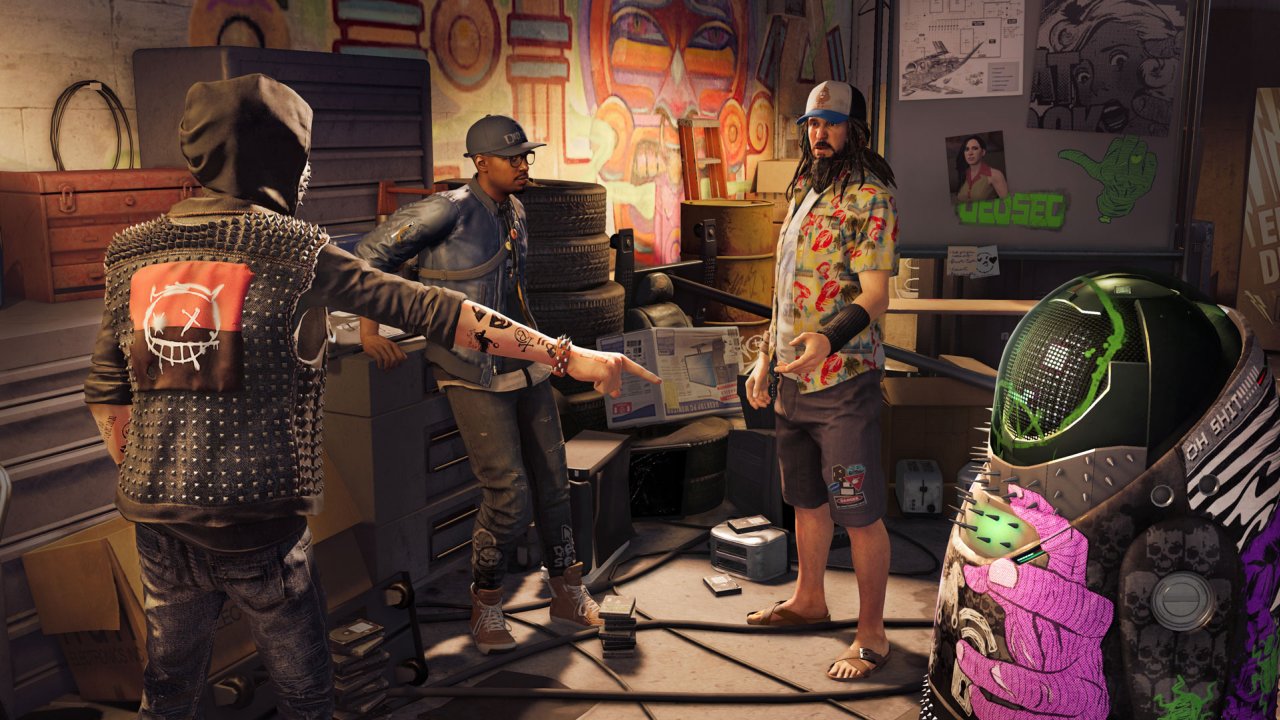
Watch Dogs 2 takes place after the events of the first game, though there are no direct connections. At the end of the original, protagonist Aiden Pearce finally managed to overcome the Central Operating System (ctOS) created by the Blume Corporation, after it had taken hold of Chicago. But Blume was not to be stopped, and since then they have deployed this ctOS 2.0 program to various locations across the United States. The sequel follows Marcus Holloway, a young man that's excellent at hacking and who, unlike Aiden, desperately wants to join the DedSec hacker group that's constantly fighting the ctOS takeover. Following a brazen infiltration, where Marcus is able to erase his criminal profile, he is accepted into the group. From there, the small team of hackers perform a variety of missions with a goal of exposing Blume's efforts to control the populace, be it through voting manipulation, selling information, getting major companies to buy into ctOS, and so on.
Much like the original game, WD2's focus on the privacy issues that are facing society is still relevant, but it never really goes beyond that. None of the characters, even Marcus himself, have any real background or motivation for why they do what they do, other than fighting "Big brother" and exposing corruption. Aiden's personal motivations may have been cliché, but at least there were some relatable reasons for why he did what he did. In Watch Dogs 2, we know little about any of the DedSec members, or why they are even friends; they are just characters with a unique personality quirk or two, grouped together for the purposes of a story. A perfect example of the underlying apathy is when a character is killed; a few tears are shed, and the group is motivated by revenge for exactly one story mission. After that, the character is never mentioned again.
Some were annoyed by Aiden Pearce's brooding, self indulgent persona. In this aspect, you can rest easy - the cast of Watch Dogs 2 are as carefree as they can be. Whether it's cracking jokes, calling each other 'bros', dropping constant f-bombs, or having drug/alcohol induced parties and one-night stands, the game absolutely never takes itself seriously. And that's actually a bit of a problem. This care-free attitude really prevents the narrative from having any sort of gravitas. As you break into huge corporations, expose their secrets, and even hack government agencies, everything comes off as a joke to the crew; just another opportunity to show off. The various thematic elements are completely at-odds with each other: Marcus is an extremely skilled hacker, in excellent physical shape, can takedown anyone with a single melee attack, can perform parkour, while mowing down legions of security guards with automatic rifles, and then party on the weekends like a frat boy. This absolutely wild combination of skills and behaviors just never feels believable or relatable.
The main story missions don't really get going until halfway through. The first half of the game feels like just a series of events which could have happened in any order; no more than a group of young adults messing around. You're not really working towards any particular goal or motivation, and there are no tangible villains or indeed boss fights to speak of. In the later stages, there are a few missions that manage to be unique and somewhat memorable in their design, and though they are fun, they are few in number and perhaps arrive too little too late. Most of the time, you're breaking into a restricted area, stealing/hacking/downloading something, and getting out. It can get repetitive, and there's often a shocking lack of security when it comes to the biggest corporations in America, as you simply walk through the front door many times. The pacing goes through all sorts of peaks and valleys, especially if you break up the main story missions with side activities. Just like the thematic clashes in gameplay, the story is also in conflict with itself – the DedSec group are acting as e-vigilantes of society, while at the same time ruining the lives of hundreds of regular citizens by stealing their money and eavesdropping on their personal lives.
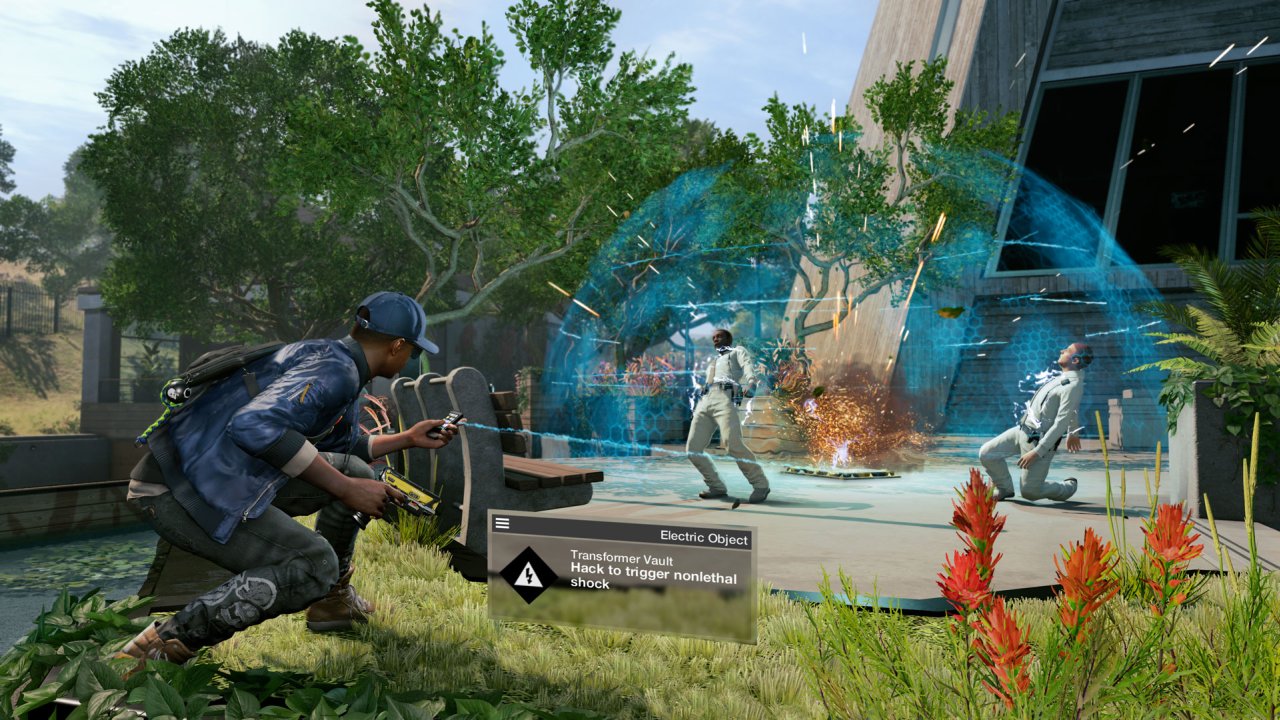
When approaching any situation, Watch Dogs 2 attempts to cater to a variety of play-styles. At its core is your smartphone, still arguably the most powerful tool in the arsenal. With it, players can manipulate the world much as you did in the original game - eavesdrop on people's text messages, hear their calls, steal their cash, and so on. Controlling security cameras remains key, as it lets you scope out the environment and mark enemies, and remote-hack other objects, all before heading inside. In hostile situations, you can make guards' phone vibrate to distract them, make their grenades explode prematurely, or cut off their signal as they try to call reinforcements. You can still make pipes underneath roads explode, or change the traffic signals, to damage and slow enemies during vehicle pursuits. Your options for interacting with some specific items have been expanded as well, and don't require skill unlocks to use. For example, fuse boxes can be turned into proximity bombs, or exploded manually, or even used to attract an enemy first. Cranes and lifts can be operated remotely, platforms can be lowered manually, and so on. Further, players can now manipulate any car or motorbike and make it go forward/reverse, or turn. This expands your arsenal of distractions during missions, gives you a chance to take away cover options, or even run over unsuspecting enemies.
But perhaps the most gameplay-impacting change comes from the two gadgets you get: a remote controlled car and a small drone. With these, Marcus can not only perform many of his hacking deeds without ever setting a foot into enemy territory, but they also provide a new level of freedom to each situation. The car can be used to go through vents and access sealed or hidden areas and hack terminals, while the drone provides a better view than security cameras and can drop off explosive gifts. These gadgets can also act as distractions if you unlock the relevant upgrades.
All of this hacking comes at a cost, of course, represented by a Botnet gauge. Yes, the entirety of the game is "very meta", from earning followers, to your Botnet gauge, to the NetHack vision we'll discuss later, and to the fact that you use a 3D printer for purchasing new guns. Anyhow - the Botnet gauge is straightforward, limiting your interactions before it needs time to recharge, or you can hack some nearby civilians to recharge faster. You can increase this gauge by purchasing upgrades with Research Points; these are earned at certain follower milestones, and can also be found hidden around the game world. Similar to the original game, you can use points to upgrade a variety of Marcus' skills, from improved weapon handling, to expanded remote control options, or the ability to call the cops on your target. To make things a bit more interesting, some of the later skills aren't just locked behind having enough research points - you must also find and collect a data schematic. These are marked on the map, but getting to them usually requires some thought via an environmental or remote control puzzle.
There's been a bit of streamlining in this sequel, so the mechanics of crafting and time-slowing Focus mode are gone. There are much fewer tools and weapons at your disposal this time around (no distraction lures, or emp grenades, etc). Players will have to rely on the basics and the environmental interactions to get them through, though some of the deployable items have been re-worked into the basic functions of your phone, like signal jamming. For those who want a less lethal approach, you carry a stun pistol at all times, as well as two weapons of your choice. The game tries to cater to three styles of play - combat, remote, and stealth, but it doesn't really execute any of them well, even compared to its predecessor.
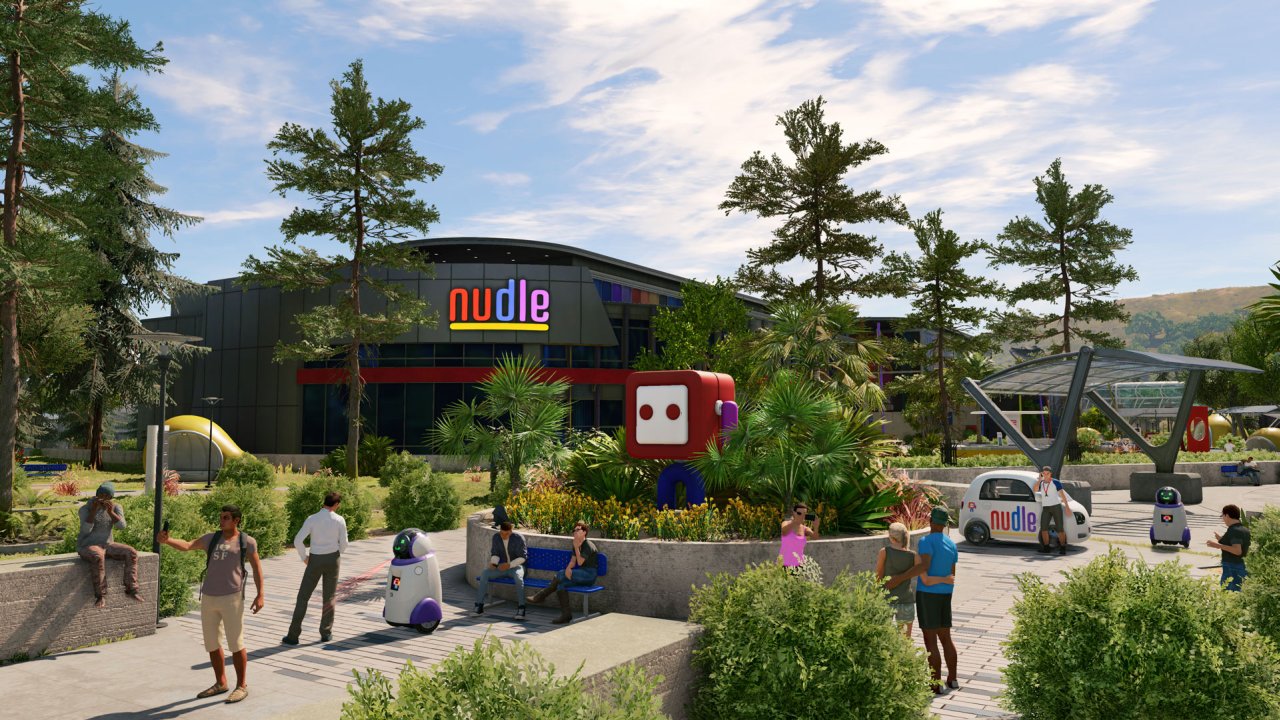
Let's take stealth. The original game managed to offer great satisfaction of sneaking into locations unnoticed, getting what you need and departing without raising an alarm. With the two remote controlled gadgets, you are off to a solid start of scoping out the place, but there are also new elements in play. Marcus can use NetHack vision, which is essentially a special view mode like in Assassin's Creed, letting you see and track enemies through walls. This vision has unlimited duration and can be used both from your own perspective, or from any object you're currently hacked into, so finding every single foe in an area is usually easy. Fans of the original game will recall that using security cameras was a key aspect, a sort of underlying minigame to find the right angle to the object you want to hack. Not so in Watch Dogs 2 - in NetHack mode, all cameras within a certain range are accessible, even when behind walls or other objects. This significantly streamlines exploration via hacking cameras, but perhaps given that you have tons of newfound exploration flexibility given the two drones, it was never meant to be a focus.
Watch Dogs 2, while offering you more options to remain in stealth, stumbles in its mechanics and AI. In this sequel, the guards are much more likely to be patrolling rather than stationary as they were in the first game. That in itself isn't an issue and in fact presents greater challenge and dynamism to the proceedings; but annoyances arise with their detection. The AI is inconsistent in how quickly and from how far away they can spot Marcus; there are occasions where being on the edge of cover would still get you spotted. The minimap is not helpful, as it shows all enemies, even if they are above or below you, in a shade of blue that's difficult to discern. You still cannot hide bodies nor do you remain hidden when performing takedowns from cover (which is rather archaic at this point); and in fact, you can't even do takedowns over the top of cover anymore, which was possible in the original.
When you do go for a melee attack, if enemies enter an alerted state even for a split second, the entire level will converge on your location. This is another bit of disappointing design and a step back from the original game, where just because an enemy saw you, you still had a moment to eliminate them (doubly so with Focus). Sometimes, enemies became instantly alerted simply because I aimed at their back but my gun got stuck in cover and so it made a sound, or if I missed a shot with a silenced weapon. Even if the only remaining enemies in the area are dogs, they still somehow trigger an alarm state. Further, enemies only stay down if you use lethal weapons or knock them out with melee; in all other cases they are simply dazed and will wake up after a while, sooner if someone finds them. Watch Dogs 2 demands perfect stealth with inconsistent and overly aggressive AI, and it's just not worth the effort most of the time.
So when it's time to go in guns blazing (as the game will force you on occasion, even if you choose to play stealthily), the same underwhelming gunplay persists for this sequel. There are only two basic enemy types in the game - normal foes and heavily armored ones; regardless if you're having shootouts with police, security guards, or gang members, the experience and AI behavior is the same. The armored foes need multiple clips to put down, but they are still susceptible to a single melee strike. You can carry only two weapons this time around, or pick up any you find during combat; dying is of little consequence, as you resume right outside the area, even during open world activities. The weapons do feel like they pack a punch, and both Marcus and his enemies go down quickly. But even with improved marksman skills unlocked, the handling doesn't feel overly precise or satisfying.
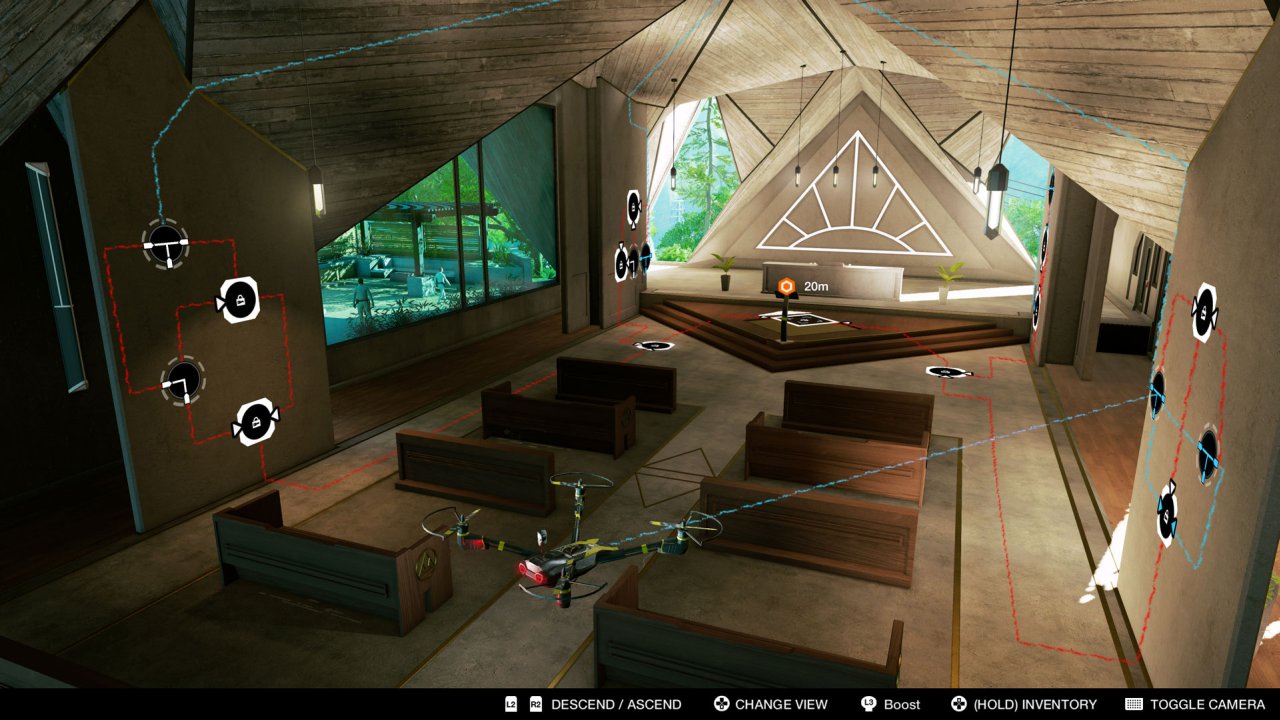
The same goes for most of Watch Dogs 2 controls - vehicle handling ranges from acceptable (bikes and boats) to atrocious (cars, especially offroad). Moving through the environment, players must hold the R2 trigger for Marcus to vault over/climb objects while doing his parkour. It never becomes all that comfortable, though it's similar to the Assassin's Creed mechanic. When trying to desperately escape, the last thing you want to do is fancy backflips off ledges. Another small controls quirk - your drones are bound to left and right on the D-Pad; this is nice for quick access, but those buttons are usually intuitive for weapon changes. Instead, you must hold Up to bring up the weapon wheel and then choose left/right for your weapons. Too many times, Marcus took out his drone for some unexpected flight time in the midst of a gun battle. Compared to the much tighter feeling games like the original Watch Dogs or this year's The Division, the controls in Watch Dogs 2 don't feel satisfying.
Outside of main missions, there's also a variety of other optional short adventures. Some last mere minutes and remind of the remote-hacking that players could do in the original game, getting a glimpse into people's private spaces. Others are a bit longer and may even include new characters. A number of missions (story and optional) involve the hacking bypass minigame, which fans of the first game will remember, as you're trying to operate a series of rotating pipes to line them up and provide power to a source. This minigame has been expanded, and rather than trying to solve the puzzle inside a simple interface, the wires now run all around the room and even around the building, giving you a cool sense of scale and a reason to use the drone. One unique mechanic has you setting up ambushes for incoming enemies, but it’s relegated to only appearing in a side mission. Some of the larger activities such as Gang Hideouts are missed here, as they provided an opportunity to flex your combat skills outside of missions.
While some side missions are provided to you, most will actually need to be discovered as you explore the open world. Unlike many Ubisoft games in the past, the world of Watch Dogs 2 is fully open and explorable from the start. You can go anywhere you please, and along the way you'll automatically discover points of interest, such as leisure activities, shops, and side missions. The shops and side activities also conveniently act as fast travel points. In typical open world fashion, the shops offer you a chance to buy cars which you can then request when in need, customize Marcus' clothing, and even buy new paint for your weapons and cars. As for side activities, they are also fairly standard - Driver SF is one side activity that puts you in the shoes of a for-hire driver that picks up clients that usually lead to crazy situations and conversations; and you can also take pictures of landmarks just as in the first game. The race activities come in three varieties; bike and drone races are straightforward, while Sailboat races require a bit of strategy as you must adjust your direction based on the wind.
There are a few quirks with the game’s world. For example, traffic can be inconsistent, with occasional empty streets and intersections even midday, which renders your 'street light' hack useless in pursuits. There’s also the ability to chat with some civilians – it makes sense to talk to your DedSec crew, but having odd and short conversations with random NPCs feels like an unnecessary feature. Civilians seem extra sensitive to your movements – sprinting down the street, they will jolt out of the way a few feet before you actually pass them; similarly they will dive out of the way if you’re speeding near (but not on) the sidewalk. But on the hand, they behave oddly during enclosed mission levels - Marcus can control a crane and crush a whole bunch of guards with it; but the civilians either ignore it, or just act shocked for a minute and then go back to their tasks. The idea of multiple gangs in the city is rather shallow – they behave much in the same way, and infiltrating their tiny restricted areas is equally similar. When you want to cause some mayhem, the response by the police can vary - they could be too tough to shake, spawning new units around the corner; or they can be tough to engage as you watch them take a wrong turn and speed away in the wrong direction, haplessly searching for you.
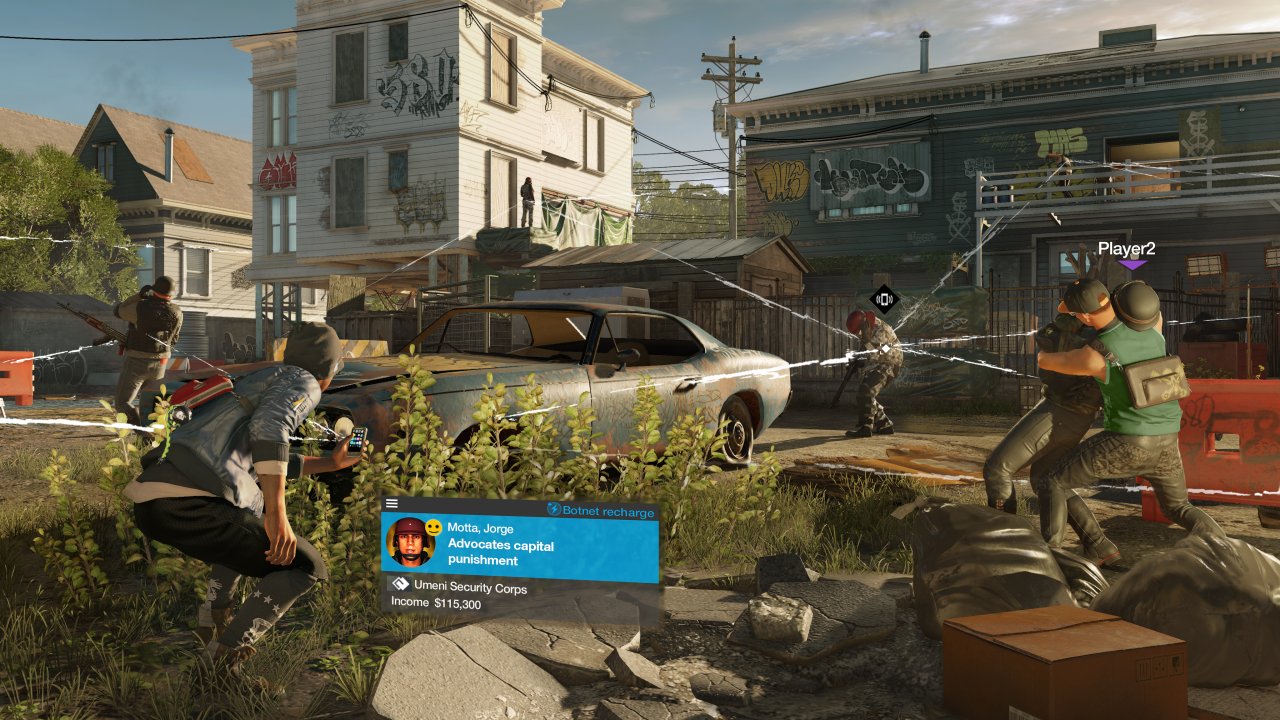
Ubisoft has always been an expert of creating the type of multiplayer modes that put players on edge, whether it’s the cat-and-mouse competitive modes of Assassin’s Creed, or the tense hacking and tailing modes of the original Watch Dogs. The sequel continues in this matter, offering players three different modes – though it’s worth noting the multiplayer component took a week after launch to actually be available. Similarly to the first game, players who choose to be online will always be at risk of being invaded by another player in the Hacking Invasion mode. The invader’s goal is to install a virus in your system – once the process begins, the victim is alerted and must find the attacker (who appears as a random NPC) within a certain radius. The intense mode is exciting for both players as the time runs out, and the area gets smaller – plus, you may find yourself invading a cooperative session, which gives you the option of which player to hack, but also puts you at a much greater risk of detection from either player.
A more direct competitive mode is the new Bounty Hunter. Players can enter this mode by chance if they attain a high wanted level, or can enter it manually. Here, one player is being chanced by both the cops and real players, with the goal of escaping and not get eliminated. Bounty Hunter can be an entertaining way to gang up on a player, but there were instances where the police would attack both the hunters and the hunted, making it more of a free-for-all rather than a pursuit scenario. Lastly, players can simply team up for a friendly co-op session and explore the game world and its special co-op missions together – this, like hacking, can happen spontaneously and automatically. If you’re not keen on a random player ruining your perfect stealth run, you can always opt out of all multiplayer.
The version of San Francisco Bay Area that Watch Dogs 2 recreates is rather wonderfully done. Much like the characters, Watch Dogs 2 is a complete polar opposite in its setting to the original game. The game world is vibrant and colorful, packed with detail and it emits a very friendly and casual atmosphere. From popular landmarks to graffiti covered alleys and rainbow sidewalks, this is a great recreation of San Francisco. NPCs roam the streets with a variety of personalities and behaviors, and certain events will cause them to call the police or an ambulance; gangs get into random shootouts with each other and the police, and on the whole the game world feels quite alive. Graphically, this is a nice looking game, with solid draw distances and nice lighting effects, though there are occasional pop-in and low resolution textures. There’s also some framerate trouble, specifically at night and also anytime the game is trying to seamlessly matchmake you into an online session. The NetHack view mode is rather ugly by comparison with a grey rendition of the world.
The sound design is well done, featuring a rather modern take on in-game audio. Like a lot of modern teens, Marcus always has his earbuds in, so you can be listening to tracks/radio during the entirety of the gameplay, save for cutscenes. Driving, walking, having a shootout – you can be rocking out to your favorite tracks. This is a good system because ambient sound in the game world is rather bland and minimal. The downside is that the music stops if there is a loading screen (fast travel, enter missions etc), so you have to start the radio station/playlist again. The game comes with an impressively expansive soundtrack, spanning from rock to hip hop and techno. You can also unlock new sounds by “spotting” them in the world if you’re nearby.

Watch Dogs 2 is a great example of a sequel that tries as hard as it can to provide a totally different feeling from its predecessor, for better or worse. The dark Chicago streets and gloomy protagonist are replaced by a bright and colorful rendition of San Francisco and a crew of happy-go-lucky hacker “bros”. While the core hacking aspect of the franchise remains unique, and the addition of two remote control drones expand your gameplay options, the experience doesn’t feel quite as tightly knit as the first game. The crew of meme-pioneers is more annoying than they are relatable, and their largely carefree attitude doesn’t allow the story to hold much weight. Plus, it is odd seeing Marcus eliminate so many enemies with firearms which still don’t feel very satisfying to hold. Even if you choose to largely stick with stealth, AI problems and general glitches will cause alarms rather frequently. The open world is rather wonderful to explore and experience, but the side activities are not as inspired as before. Multiplayer, now that it finally works, does offer some unique thrills. If you disliked the story and protagonist of the original Watch Dogs, this sequel may change your mind, but it comes at the expense of gameplay that’s seemingly regressed in a few areas.
 Comments
Comments




















